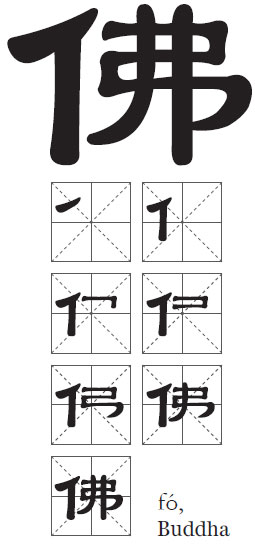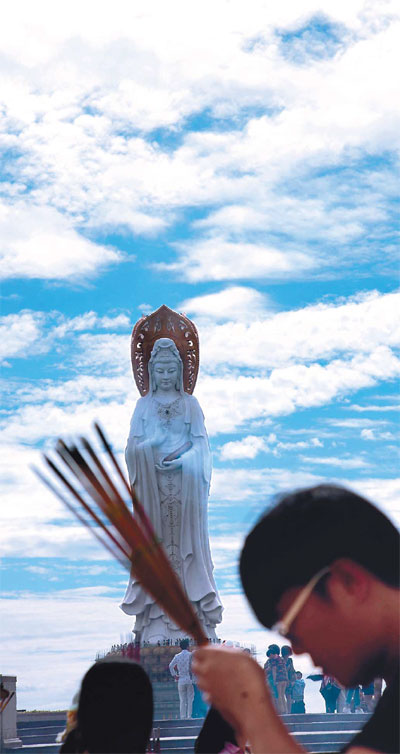The business of Buddha
Updated: 2015-01-23 07:03
By Huang Yuanjing(China Daily Europe)
|
|||||||||||
High entrance fees at well-known temples and high-profile abbots driving fancy cars compromise the saintly image of priests as above materialism
In October, Nyima Dorjee Rinpoche, abbot of Palden Ningye Monastery, set off on a journey to what Tibetans call "Handi", which loosely translates into "the Han ethnic land". He was on a sacred mission to visit Mount Wutai in Shanxi province.
China has four sacred mountains in Buddhism, but Mount Wutai is the most celebrated. It was a particularly special destination for Nyima Rinpoche because it is the "Seat of Awakening" for Manjusri, a bodhisattva of wisdom, who Nyima believes was reincarnated as his mentor.
|
Pilgrims worship a monument outside Nanshan Monastery in Hainan province. Provided to China Daily |
For this well-traveled, 38-year-old monk, the site is one of many pilgrimages on the quest for ultimate wisdom. He felt a sense of accomplishment and exhilaration when he encountered the valley filled with monasteries. Marshaling the utmost respect, Nyima performed his sutras and carefully groomed himself before entering the mountains.
From there, things started to go horribly wrong. In a particularly grand monastery, he saw two monks sitting with their feet resting on chairs "like two bosses," he says. He asked which monastery was the most ancient. They didn't know. He inquired about the differences between Han and Tibetan Buddhism. They didn't know.
Nyima asked if they were converted; they merely showed Nyima their conversion certificates, which they kept in their chest pockets. As to the real meaning of conversion (皈依), they were clueless, he says.

"They knew nothing!" Nyima exclaims. "Conversion is not about papers, it's about here." He laid his palm on his chest. "These temples are magnificent, but there was no Buddha, or Buddha's Way, in them. They are hollow."
Nyima left Mount Wutai disillusioned and saddened. "This is what happens in the Downfall Era of Buddhism."
The Downfall Era of Buddhism (末法时代) is often cited as the reason for the ills of Buddhism in modern times. Before he attained nirvana, Buddha predicted the downfall of his own religion in three phases, the first being the first thousand years of thriving, a second thousand years of reflection on the first phase, and the third millennium being the downfall.
In China, at times, the situation looks particularly disheartening. For many Chinese people, the traditional image of a Buddhist monk is somewhat like that of a saint: thin, dignified, and a trusted guide on spiritual matters - perhaps even a psychic with supernatural powers. But, most of all, they should neither have nor want money. This romanticized image causes antipathy toward many of the modern Chinese Buddhist monks of today.
For starters, an ordinary pilgrim needs to be quite well off to visit a monastery. Most temples charge an entrance fee, and a lot of them are high enough to bar most pilgrims from regular entry. You can find a donation box by every gate of every hall. When you enter a monastery, you often are coerced into buying a candle or putting your family name down for a ceremony, with monks offering guarantees of good luck and fortune.
Meanwhile, as China gets richer, Buddhism's patrons give more and more generous offerings. In some wealthy monasteries, abbots can be seen driving a BMW, Audi, or even a Porsche -gifts from wealthy patrons with now assuredly spectacular karma. Shi Yongxin (释永信), abbot of Shaolin Monastery and possibly the most well-known monk in China, is commonly called the "CEO of Shaolin" because he has started more than 10 companies under Shaolin's name. For some, the death of the romantic ideal has caused a loss in faith, and for many others, the perception of Buddhism has changed to one of greedy monks, expensive incense and tourist hotspots.
If, indeed, this is the millennium of the downfall, how did it come about? Gao Xiang, a member of the Beijing Buddhist Association and a well-known online celebrity for his Buddhism advocacy, believes it is the price of the modern world. "It's not that monasteries want to be commercialized - they have to. They are forced to." A long history of Buddhism in flux has led to Gao's view, a view many share.
With the exception of a few monasteries of unsurpassed historical value, most temples were converted or turned into rubble in the 1970s. Before 1949, Beijing had more than 700 monasteries within the Second Ring Road; now there are only 20.
When the 1980s and 1990s arrived, new challenges presented themselves. Just when Buddhism was staggering into recovery, money presented a new hurdle.
Tourism, which barely existed previously, became all the rage. Han Buddhism, especially its Chan (known in Japan as Zen) branch, has a tradition of seclusion and hermitage, keeping the practice as far away from the hurly-burly as possible with monasteries hidden in remote mountain areas.
However, with these mountains developed into jingqu (景区, commercial scenic areas), monasteries were trapped in the center, with tourist buses flocking to their gates on newly built roads. Temples fell under the jurisdiction of three government departments: the Tourism Bureau (旅游局), the Landscape and Forestry Bureau (园林局) and the Cultural Heritage Bureau (文物局). The first thing they did was begin to charge entrance fees.
Abbot Haixin, vice-president of the Shanxi Buddhism Association, was a new monk when the news broke that Mount Wutai was going to charge a fee of 0.20 yuan (3 US cents, 0.03 euros), in the 1980s.
Today, fees for some Chinese temples and monasteries can be prohibitively high for some, leaving embittered pilgrims. The entrance fee to Mount Wutai in Shanxi province is 238 yuan, Shaolin Monastery in Henan province charges 100 yuan, and Nanshan Monastery in Hainan province costs 170 yuan, to name just a few.
But while most blame the monasteries, few are aware that most monks and nuns are against it and have petitioned to lift the fees at every National Buddhist Convention. Shi, of the Shaolin Monastery, has been petitioning the central government to lift the fee for over 10 years because "it blocks the over 1,000-year-old pilgrimage path and bars pilgrims". He has had no success. Seventy percent of the Shaolin Monastery's fees go to the local government and the developer.
In 2014, seven monasteries in Jizushan Mountain, Yunnan province, collectively closed their gates to visitors in protest against the tourism developer's intention to charge an entrance fee. Thanks to the media attention, they succeeded.
"If the entrance fee is lifted, who will suffer most?" Gao, the online celebrity, asks. "Not the monasteries. Monasteries will only be better if these fees are removed. It's these three government sectors that have benefited from it the most."
Abbot Haixin frowns and shakes his head anxiously. "It's not about money, it's about people's hearts," he says. "It is giving out one message: If you are poor, you are not allowed to pay your homage to Buddha. It is an unwritten insult to those who cannot afford it. It's no longer about 238 yuan, but about discrimination and disrespecting people."
The abbot, still shaking his head, says: "Did the government build the mountain? Did it build the monastery? If not, no one has a right to charge a fee. We have focused so much on economic development that we are ignoring spiritual and religious things. Buddhism is supposed to save people's hearts, but look what it has become."
Courtesy of The World of Chinese, www.theworldofchinese.com
The World of Chinese
(China Daily European Weekly 01/23/2015 page27)
Today's Top News
China offers Swiss $8b quota for yuan trading
Best team China in decade carries countrymen's hope
Russia says DPRK sent positive signal on Kim visit in May
Australia PM quashes rumours of unrest as 'nonsense'
China aims for stronger links with fragile Europe
China to instill national characteristics in think tanks
Shanghai govt releases report on stampede tragedy
Fake condoms, Viagra, seized and online network shut down
Hot Topics
Lunar probe , China growth forecasts, Emission rules get tougher, China seen through 'colored lens', International board,
Editor's Picks

|

|

|

|

|

|






